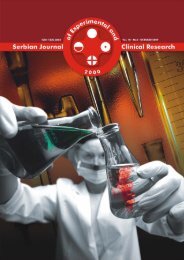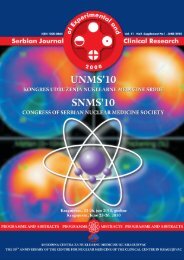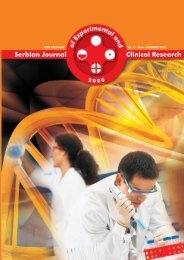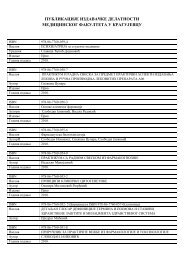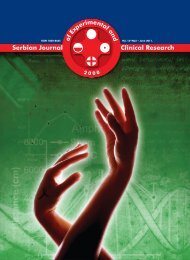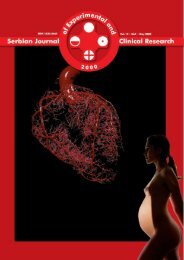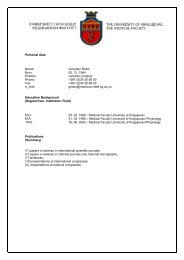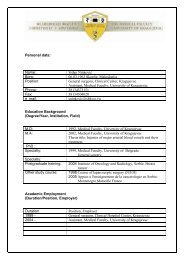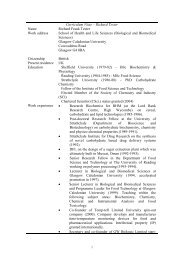neurotoxicity and mechanisms of induced hyperexcitability
neurotoxicity and mechanisms of induced hyperexcitability
neurotoxicity and mechanisms of induced hyperexcitability
Create successful ePaper yourself
Turn your PDF publications into a flip-book with our unique Google optimized e-Paper software.
LETTER TO THE EDITOR PISMO UREDNIKU LETTER TO THE EDITOR PISMO UREDNIKUTHE RELATIONSHIP BETWEEN SPORTS ENGAGEMENT,BODY MASS INDEX AND PHYSICALABILITIES IN CHILDRENPredrag Lazarevic 1 , Vladimir Zivkovic 1 , Milena Vuletic 1 , Nevena Barudzic 1 <strong>and</strong> Dejan Cubrilo 11Department for Physical Education, Faculty <strong>of</strong> Medicine, University <strong>of</strong> Kragujevac, KragujevacReceived / Primljen: 21. 05. 2010. Accepted / Prihvaćen: 11. 04. 2011.ABSTRACTHypokinesia, which is a consequence <strong>of</strong> modern technologicaldevelopment, is now one <strong>of</strong> the three biggest health risk factors.Whereas physical inactivity <strong>and</strong> obesity in adults is subject<strong>of</strong> concern, these factors in children presage an even greater publichealth problem because many health-related problems <strong>and</strong>life-threatening diseases begin in childhood <strong>and</strong> adolescence.It has been noted that regular physical activity modulatesvascular endothelial function via an effect on basal nitric oxide(NO) production, thus leading to a significant reductionin the incidence <strong>of</strong> cardiovascular disease (1). Exercise canalso increase energy expenditure <strong>and</strong> can create a negativeenergy balance. Conversely, scientific data regarding the effect<strong>of</strong> school-based physical activity interventions on bodymass index (BMI) in children are conflicting (2, 3). Moreover,there is insufficient clinically useful scientific data on BMI inchildren <strong>and</strong> its possible association with motor skills. Withboth sexes, motor abilities improve from physical developmentin adolescents, <strong>and</strong> regular sports training influencesfitness <strong>and</strong> motor abilities.The aim <strong>of</strong> our study was to evaluate the morphologicalstatus <strong>and</strong> physical abilities <strong>of</strong> 13-year-old children in orderto investigate the relationship between sports engagement,BMI <strong>and</strong> physical abilities. The results <strong>of</strong> our study shouldgive coaches important parameters in the selection <strong>of</strong> youngathletes, as well as provide them with information that maybe useful in training <strong>and</strong> programming assignments.MATERIALS AND METHODSThe research was carried out with a group <strong>of</strong> 67 boysfrom an elementary school. The boys were 12-13 years old<strong>and</strong> had differing sports training experiences.After an assessment <strong>of</strong> morphological characteristics(height, weight, BMI), the children were subjected to a battery<strong>of</strong> motor tests designed to test speed <strong>and</strong> coordination(Jumping <strong>and</strong> going through Swedish boxes, slalom with 3balls, h<strong>and</strong> tapping, 50-m sprint, 30-m flying start sprint<strong>and</strong> 20-m slalom sprint (4)).RESULTS AND DISCUSSIONThe average BMI <strong>of</strong> the children who participated inthe study was 19.2±3.4. After transforming BMI data toappropriate percentiles according to the formulas proposedby the National Center for Health Statistics <strong>of</strong>United States (5), we classified each subject into one <strong>of</strong>four groups: underweight (athletes vs. non-athletes: 7.7%vs. 17.8%), healthy weight (69.2% vs. 46.4%), overweight(12.8% vs. 21.4%) <strong>and</strong> obese (10.2% vs. 14.3%). AlthoughBMI is thought to measure excess weight rather than excessbody fat, if appropriate cut-<strong>of</strong>f points are used, a highBMI level is a moderately sensitive <strong>and</strong> very specific indicator<strong>of</strong> excess adiposity among children (6).Since hypokinesis in children <strong>and</strong> adolescents is thoughtto be a growing problem, especially in urban places, it isencouraging that 58.2% <strong>of</strong> the boys in the study statedthat they participated in a sport activity. To determine ifsport activity influences morphological status <strong>of</strong> young 13-year-old boys, we applied a contingency analysis (χ2-test)<strong>and</strong> found no significant difference between children whotrain for a sport <strong>and</strong> those that do not. These results are inagreement with many other studies that have found that, incontrast to biological growth, the absence <strong>of</strong> involvementin sports activities in children is not the main factor thatinfluences their morphological status <strong>and</strong> physical fitness.Moreover, an analysis <strong>of</strong> morpho-functional skills <strong>of</strong> youngUDK 613.71-053.6 / Ser J Exp Clin Res 2011; 12 (1): 41-42Correspondence: Predrag Lazarevic, Assistant trainee in Physical Education, Faculty <strong>of</strong> Medicine, University <strong>of</strong> KragujevacSvetozara Markovica 69, 34000 Kragujevac, Republic <strong>of</strong> Serbia, Tel. +381 64 877 66 68, E-mail: plazarevickg@sbb.rs41



